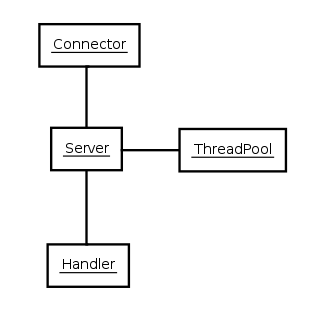Argo part 1 - Jetty
Argo(https://github.com/58code/Argo) is a lightweight web framework open-sourced by 58.com(the craigslist in china).
Background
Before I read the source code of this project, I have only the Java language background, but no experience in web container, Spring, Servlet, tomcat, jetty. So the first question that hit me is how does Argo works?
There is a example in the folder samples/hello-world, but i could not find any Main function. From the document file Readme, running Argo needs only one command:
maven jetty:run
I known maven is a project management tool like ant, but what is jetty? I don’t know the relationship between this command with Argo.
Jetty
After googling, i found some useful pages about jetty in the following URL.
http://wiki.eclipse.org/Jetty/Feature/Jetty_Maven_Plugin
http://wiki.eclipse.org/Jetty/Reference/Jetty_Architecture
1) jetty is a web container like tomcat.
At first, I thought it may existing some configurations of jetty that would relate to Argo. But in the file samples/hellow-world/pom.xml, I could only found the following statements:
<plugin>
<!-- http://wiki.eclipse.org/Jetty/Feature/Jetty_Maven_Plugin -->
<groupId>org.mortbay.jetty</groupId>
<artifactId>jetty-maven-plugin</artifactId>
<configuration>
<stopPort>9966</stopPort>
<stopKey>foo</stopKey>
<scanIntervalSeconds>0</scanIntervalSeconds>
<connectors>
<connector implementation="org.eclipse.jetty.server.nio.SelectChannelConnector">
<port>80</port>
<maxIdleTime>60000</maxIdleTime>
</connector>
</connectors>
<webAppConfig>
<contextPath>/</contextPath>
</webAppConfig>
</configuration>
</plugin> We can see the connector implementation is org.eclipse.jetty.server.nio.SelectChannelConnector. But it seems less relationship with hellow-world.
The only thing that may have connections with hello-world project is webAppConfig. But it only defines a contextPath.
2) When running jetty:run, jetty will deploy the web application based on:
- resources in ${basedir}/src/main/webapp
- classes in ${project.build.outputDirectory}
- web.xml in ${basedir}/src/main/webapp/WEB-INF/
I can find three html files are in the directory src/main/webapp,but no configurations. Also, there is no web.xml. So the only possible configuration is inside the source code( HelloController.java,HomeController.java ).
3) jetty has the following architecture:

The Connector receives Http connections. The Handle handles request from the Connector,and gives a response. Also, a ThreadPool is used to do thread works.
4) The Connector and the Handler can be configured in:
- In code. See the examples in the Jetty 7 Latest Source XRef.
- With Jetty XML - dependency injection style XML format.
- With your dependency injection framework of choice: Spring or XBean.
- Using Jetty WebApp and Context Deployers.
No Main function to call jetty in code, no XML configuration files. Not configured in webapp.
So, I’m in certain that Argo used the dependency injection technique. That is, Argo use dependency injection to configure jetty.
Dependency Injection
http://stackoverflow.com/a/140655/732267
http://www.jamesshore.com/Blog/Dependency-Injection-Demystified.html
http://helloj2ee.googlecode.com/files/DependencyInjection.pdf //strongly recommended
An example in DependencyInjection.pdf:
class MovieLister{
private final MovieFinder finder;
public MovieLister() {
finder = new ColonDelimitedMovieFinder(“movies.txt”);
}
public Movie[] moviesDirectedBy(String arg) {
List allMovies = finder.findAll(); //<---
for (Iterator it = allMovies.iterator(); it.hasNext();) {
Movie movie = (Movie) it.next();
if (!movie.getDirector().equals(arg)) it.remove();
}
return (Movie[]) allMovies.toArray(new Movie[allMovies.size()]);
}The MovieLister relies on MoiveFinder. Directly!
By using dependency injection, you can eliminate this dependency, and inject a proper MovieFinder implementation when using MovieLister
public class MovieLister {
private final MovieFinder finder;
public MovieLister(MovieFinder finder) {
this.finder = finder;
}
public List<Movie> moviesDirectedBy(String arg) {
List<Movie> movies = finder.findAll();
for ( Iterator<Movie> it = movies.iterator(); it.hasNext(); ) {
Movie movie = it.next();
if ( !movie.getDirector().equals(arg) ) {
it.remove();
}
}
return movies;
}
}You may have used this technique in OO, without knowing that it is also a implement of dependency injection.
The dependency injection can be implemented by:
- Constructor Injection (like the MovieLister above)
- Setter Injection
- Interface Injection
Let’s come back to Argo.
Dependency Injection in Argo
The interface that HelloController implements is ArgoController, which is defined as:
/**
* interface that a Controller class should implemented
*/
public interface ArgoController {
/**
* Called when instantiated by injector
*/
void init();
}We can speculate that Argo use interface injection, and ArgoController is strongly related to Dependency Injection.
Web Container: jetty & tomcat
We known jetty gets the configuration by interface injection, and then can starts the Hello-world web application.
Another tool that could be used to run Hello-world web application is tomcat. In fact, jetty and tomcat are web contains that supports Servlets Filters.
http://stackoverflow.com/questions/1893253/tomcat-web-server-or-web-container http://stackoverflow.com/questions/12689910/difference-between-web-server-web-container-and-application-server
tomcat configuration is similar to jetty: (samples/hellow-world/pom.xml)
<plugin>
<groupId>org.apache.tomcat.maven</groupId>
<artifactId>tomcat7-maven-plugin</artifactId>
<version>2.0</version>
<configuration>
<path>/</path> <!--/argo -->
<port>80</port>
</configuration>
</plugin>PS: It must clarified that only servlet 3.0 supports annotation based injection. So, if you used tomcat 6, you still needs to configure the web.xml:
<filter>
<filter-name>mvcfilter</filter-name>
<filter-class>com.bj58.argo.servlet.ArgoFilter</filter-class>
</filter>Conclusion
Argo use interface injection to achieve the Dependency Injection. The interface related is com.bj58.argo.ArgoController.
Argo is configured by Dependency Injection. And jetty/tomcat used these configurations to bootstrap a web application.
Hailin Zeng 29 March 2013 blog comments powered by Disqus